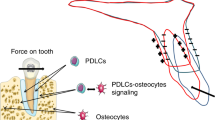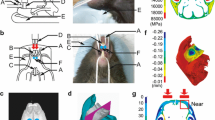Abstract
Objectives
Clinicians occasionally face the challenge of moving a tooth through the maxillary sinus. The objective of this study was to evaluate tissue remodeling during tooth movement into the maxillary sinus, more specifically as regards to bone formation.
Materials and methods
The maxillary first molar of 20 male mice was moved toward the palatal side by a nickel–titanium super elastic wire for 1 to 14 days, and the bone remodeling around the root was evaluated using histomorphometry and immunodetection of bone-restricted Ifitm-like (Bril) protein, a novel marker of active bone formation.
Results
When mechanical stress was applied to the tooth, the periodontal ligament on the palatal side was immediately compressed to approximately half of its original width by the tipping movement of the tooth. At the same time, osteoblasts deposited new bone on the wall of the maxillary sinus prior to bone resorption by osteoclasts on the periodontal side, as evidenced by the high level of expression of Bril at this site. As a result of these sequential processes, bone on the sinus side maintained a consistent thickness during the entire observation period. No root resorption was observed.
Conclusions
Bone formation on the surface of the maxillary sinus was evoked by mechanotransduction of mechanical stress applied to a tooth over a 2-week period, and was induced ahead of bone resorption on the periodontal ligament side.
Clinical relevance
Mechanical stress can be exploited to induce bone formation in the maxillary sinus so that teeth can be moved into the sinus without losing bone or causing root damage.




Similar content being viewed by others
References
Krishnan V, Davidovitch Z (2006) Cellular, molecular, and tissue-level reactions to orthodontic force. Am J Orthod Dentofacial Orthop 129(469):e1–e32
Wise GE, King GJ (2008) Mechanisms of tooth eruption and orthodontic tooth movement. J Dent Res 87:414–434
von Böhl M, Kuijpers-Jagtman AM (2009) Hyalinization during orthodontic tooth movement: a systematic review on tissue reactions. Eur J Orthod 31:30–36
Wehrbein H, Bauer W, Wessing G, Diedrich P (1990) The effect of the maxillary sinus floor on orthodontic tooth movement. Fortschr Kieferorthop 51:345–351
Lindskog-Stokland B, Wennstrom JL, Nyman S, Thilander B (1993) Orthodontic tooth movement into edentulous areas with reduced bone height. An experimental study in the dog. Eur J Orthod 15:89–96
Wehrbein H, Fuhrmann RA, Diedrich PR (1995) Human histologic tissue response after long-term orthodontic tooth movement. Am J Orthod Dentofacial Orthop 107:360–371
Cacciafesta V, Melsen B (2001) Mesial bodily movement of maxillary and mandibular molars with segmented mechanics. Clin Orthod Res 4:182–188
Re S, Cardaropoli D, Corrente G, Abundo R (2001) Bodily tooth movement through the maxillary sinus with implant anchorage for single tooth replacement. Clin Orthod Res 4:177–181
Moffatt P, Gaumond MH, Salois P, Sellin K, Bessette MC, Godin E, de Oliveira PT, Atkins GJ, Nanci A, Thomas G (2008) Bril: a novel bone-specific modulator of mineralization. J Bone Miner Res 23:1497–1508
Sakai Y, Balam TA, Kuroda S, Tamamura N, Fukunaga T, Takigawa M, Takano-Yamamoto T (2009) CTGF and apoptosis in mouse osteocytes induced by tooth movement. J Dent Res 88:345–350
Nanci A, Wazen RM, Zalzal SF, Fortin M, Goldberg HA, Hunter GK, Ghitescu DL (2004) A tracer study with systemically and locally administered dinitrophenylated osteopontin. J Histochem Cytochem 52:1591–1600
Schroeder HE (1991) The rate of the eruption of human teeth. A review. Schweiz Monatsschr Zahnmed 101:279–284
Nanci A (2008) Ten Cate’s oral histology, 6th edn. Mosby, St. Louis, pp 108–140
Lozupone E, Favia A, Grimaldi A (1992) Effect of intermittent mechanical force on bone tissue in vitro: preliminary results. J Bone Miner Res 7(Suppl 2):S407–409
Srouji S, Kizhner T, Ben David D, Riminucci M, Bianco P, Livne E (2009) The Schneiderian membrane contains osteoprogenitor cells: in vivo and in vitro study. Calcif Tissue Int 84:138–145
Kim SW, Lee IK, Yun KI, Kim CH, Park JU (2009) Adult stem cells derived from human maxillary sinus membrane and their osteogenic differentiation. Int J Oral Maxillofac Implants 24:991–998
Lundgren S, Andersson S, Gualini F, Sennerby L (2004) Bone reformation with sinus membrane elevation: a new surgical technique for maxillary sinus floor augmentation. Clin Implant Dent Relat Res 6:165–173
Palma VC, Magro-Filho O, de Oliveria JA, Lundgren S, Salata LA, Sennerby L (2006) Bone reformation and implant integration following maxillary sinus membrane elevation: an experimental study in primates. Clin Implant Dent Relat Res 8:11–24
Thor A, Sennerby L, Hirsch JM, Rasmusson L (2007) Bone formation at the maxillary sinus floor following simultaneous elevation of the mucosal lining and implant installation without graft material: an evaluation of 20 patients treated with 44 Astra Tech implants. J Oral Maxillofac Surg 65(7 Suppl 1):64–72
Srouji S, Ben-David D, Lotan R, Riminucci M, Livne E, Bianco P (2010) The innate osteogenic potential of the maxillary sinus (Schneiderian) membrane: an ectopic tissue transplant model simulating sinus lifting. Int J Oral Maxillofac Surg 39:793–801
Ahn JJ, Cho SA, Byrne G, Kim JH, Shin HI (2011) New bone formation following sinus membrane elevation without bone grafting: histologic findings in humans. Int J Oral Maxillofac Implants 26:83–90
Daimaruya T, Takahashi I, Nagasaka H, Umemori M, Sugawara J, Mitani H (2003) Effects of maxillary molar intrusion on the nasal floor and tooth root using the skeletal anchorage system in dogs. Angle Orthod 73:158–166
Allori AC, Sailon AM, Pan JH, Warren SM (2008) Biological basis of bone formation, remodeling, and repair—part III: biomechanical forces. Tissue Eng Part B Rev 14:285–293
Krishnan V, Davidovitch Z (2009) On a path to unfolding the biological mechanisms of orthodontic tooth movement. J Dent Res 88:597–608
Hambli R, Rieger R (2011) Physiologically based mathematical model of transduction of mechanobiological signals by osteocytes. Biomech Model Mechanobiol 11(1–2):83–93
Creekmore TD, Eklund MK (1983) The possibility of skeletal anchorage. J Clin Orthod 17:266–269
Segal GR, Schiffman PH, Tuncay OC (2004) Meta analysis of the treatment-related factors of external apical root resorption. Orthod Craniofac Res 7:71–78
Weltman B, Vig KW, Fields HW, Shanker S, Kaizar EE (2010) Root resorption associated with orthodontic tooth movement: a systematic review. Am J Orthod Dentofacial Orthop 137:462–476
Umemori M, Sugawara J, Mitani H, Nagasaka H, Kawamura H (1999) Skeletal anchorage system for open-bite correction. Am J Orthod Dentofacial Orthop 115:166–174
Kuroda S, Sugawara Y, Deguchi T, Kyung HM, Takano-Yamamoto T (2007) Clinical use of miniscrew implants as orthodontic anchorage: success rates and postoperative discomfort. Am J Orthod Dentofacial Orthop 131:9–15
Kuroda S, Katayama A, Takano-Yamamoto T (2004) Severe anterior open-bite case treated using titanium screw anchorage. Angle Orthod 74:558–567
Kuroda S, Sugawara Y, Tamamura N, Takano-Yamamoto T (2007) Anterior open bite with temporomandibular disorder treated with titanium screw anchorage: evaluation of morphological and functional improvement. Am J Orthod Dentofacial Orthop 131:550–560
Kuroda S, Sakai Y, Tamamura N, Deguchi T, Takano-Yamamoto T (2007) Treatment of severe anterior open bite with skeletal anchorage in adults: comparison with orthognathic surgery outcomes. Am J Orthod Dentofacial Orthop 132:599–605
Yamada K, Kuroda S, Deguchi T, Takano-Yamamoto T, Yamashiro T (2009) Distal movement of maxillary molars using miniscrew anchorage in the buccal interradicular region. Angle Orthod 79:78–84
Acknowledgments
We extend our thanks Cynthia Török for the technical assistance. This study was supported by the Canadian Institutes of Health Research. Pierre Moffatt is supported by the Shriners of North America.
Conflict of interest statement
The authors declare that they have no conflict of interest.
Author information
Authors and Affiliations
Corresponding author
Rights and permissions
About this article
Cite this article
Kuroda, S., Wazen, R., Moffatt, P. et al. Mechanical stress induces bone formation in the maxillary sinus in a short-term mouse model. Clin Oral Invest 17, 131–137 (2013). https://doi.org/10.1007/s00784-012-0686-4
Received:
Accepted:
Published:
Issue Date:
DOI: https://doi.org/10.1007/s00784-012-0686-4




